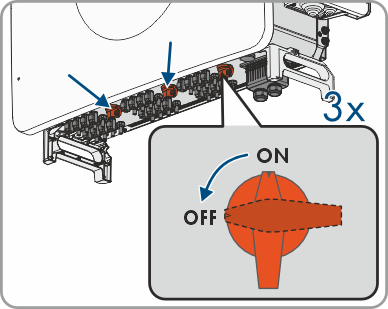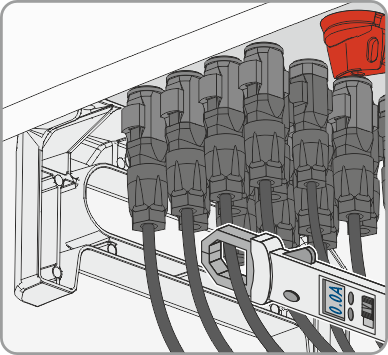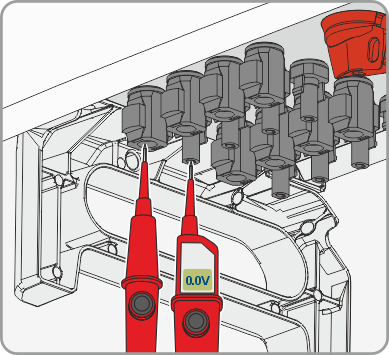Disconnecting the Inverter from Voltage Sources
 Qualified person
Qualified person
Prior to performing any work on the inverter, always disconnect it from all voltage sources as described in this section. Adhere to the prescribed sequence.
 WARNING
WARNING
Danger to life due to electric shock from destruction of the measuring device due to overvoltage
Overvoltage can damage a measuring device and result in voltage being present in the enclosure of the measuring device. Touching the live enclosure of the measuring device results in death or lethal injuries due to electric shock.
- Only use measuring devices with a measurement ranges designed for the maximum AC and DC voltage of the inverter.
Procedure:
- Shut down the AC voltage supply and secure against unintentional reconnection.
- Switch off all 3 DC load-break switches of the inverter and secure against reconnection.
- Wait until the LEDs have gone out.
- Use a current clamp to ensure that no current is present in the DC cables.
- Note the position of the DC connectors.
- Wear insulated gloves and use insulated tools when working on the DC connectors.
- Ensure that the DC connectors are in perfect condition and that none of the DC conductors or DC plug contacts are exposed.
- Carefully release and remove the DC connectors as described in the following.
- Unlock the DC connector using the corresponding unlocking tool and remove (refer to the manufacturer manual for further information).
- Ensure that the DC connectors on the product and those that are equipped with DC conductors are in perfect condition and that none of the DC conductors or DC plug contacts are exposed.
- Ensure that no voltage is present at the DC inputs on the inverter using a suitable voltage detector.
- Wait 5 minutes before proceeding.
- Check that there is no voltage at the AC connection between L1 and L2, L2 and L3, L1 and L3 and L1 and grounding conductor, L2 and grounding conductor, L3 and grounding conductor and between L1 and N, L2 and N and L3 and N using a suitable voltage detector. For this purpose, hold the test prods to the conductors' ring terminal lugs.


 DANGER
DANGER
Danger to life due to electric shock when touching exposed DC conductors or DC plug contacts if the DC connectors are damaged or loose
The DC connectors can break or become damaged, become free of the DC cables, or no longer be connected correctly if the DC connectors are released and disconnected incorrectly. This can result in the DC conductors or DC plug contacts being exposed. Touching live DC conductors or DC plug connectors will result in death or serious injury due to electric shock.

 DANGER
DANGER
Danger to life due to high voltages
Even after disconnection, there are residual voltages on the product that must be removed.
